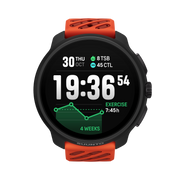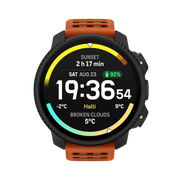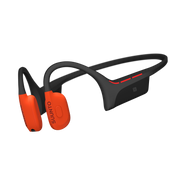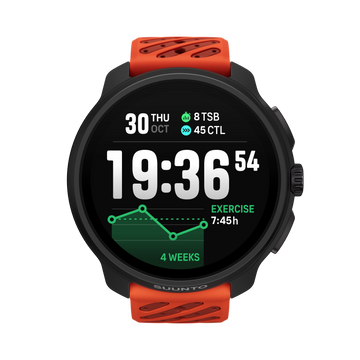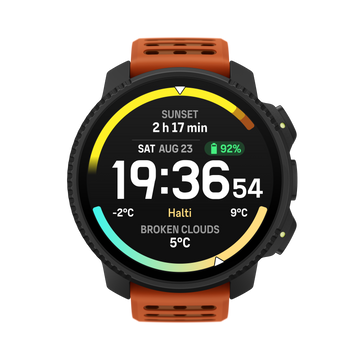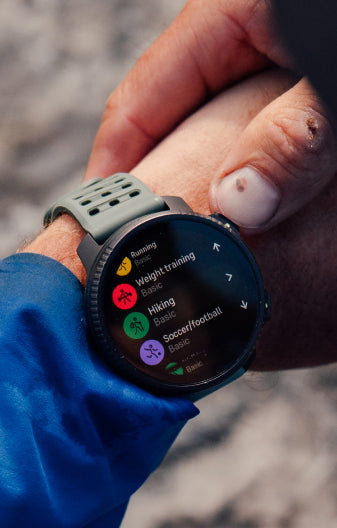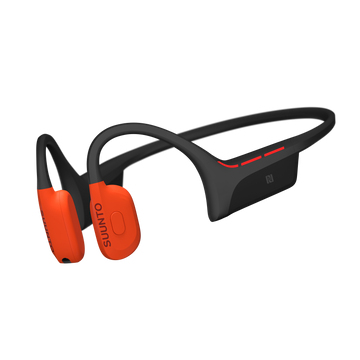

Suunto Blog

Suunto Vertical keeps evolving
Follow the latest updates and developments of your Suunto Vertical GPS watch and enjoy it to its full potential.
On this page you can see in a timeline view how your Suunto Vertical has evolved since it was launched in June 2023.
To always have the latest watch software, we recommend you enable automatic, over the air software updates in the watch settings. Also, make sure you are using the latest version of Suunto app for iOS or for Android.
You can find dozens of SuuntoPlus sports apps in Suunto mobile app’s SuuntoPlus Store and the ever-growing list of Suunto compatible partner services is here.
March 2024
The new Vertical Week sports app was published to SuuntoPlus Store. The SuuntoPlus Vertical Week sports app can be used to track the total elevation gain of multiple workouts during the week. Learn more about Suunto World Vertical Week 2024.
Pace your mountain races with SuuntoPlus Vertical Race sports app. The Vertical Race sports app is designed to be used on vertical races. Set you race distance, vertical meters and goal time and follow the pace data live on your Suunto.
Follow and improve your running technique with Stryd SuuntoPlus sports app. The Stryd sensor provides data such as ground contact time, vertical oscillation, leg stiffness and impact loading rate. Read more about improving your running technique with Suunto and Stryd here
For ultrarunners, there is now an Ultrarun& walk SuuntoPlus sports app that will track how much one runs, walks, or stays still on the race. The app helps you to pace & analyse long efforts. This sports app has been built by trailrunner Alessio Sclocco who is also part of Suunto fieldtest community.
A software update for Suunto Vertical, Suunto Race and Suunto 9 Peak Pro was released. The update delivered three new watch faces, better support for emojis in mobile notifications and a pause reminder.
The update also provided navigation enhancements with improved high contrast map style for use with always on display and a new ruler tool to measure distances on map to nearby locations.
Suunto app was updated with performance improvements to data sync between watch and Suunto app and a user interface change to how workout summary values are shown in the app.
New Suunto connected partner services include Base de Vitesse aimed for surfers and sailors, Be Number one sport for competing in your sports, MoveEffect aimed for corporate health and Mia Health to engage in your fitness journey.
You can find the latest list of partners from here
February 2024
New Winter maps map layer with downhill and cross-country skiing tracks came available in Suunto app to help you find the best places to ski.
Waypoint import was improved for GPX route import with better waypoint compatibility with route planning services.
Training Zone Summary now shows swim pace, average power and normalised power.
Performance improvements to data sync between watch and Suunto app
Suuntoplus Power Zones and Pace Zones sports apps were published for runners and riders. Now you can follow the cumulative time in each zone and see which zone you currently are working out.
Suunto is now compatible Xioami MiFitness. Xiaomi users can now connect their devices with Suunto via Mifitness app. This gives the possibility to use Suunto app tools as well as get connected with Suunto ecosystem. Read more here.
January 2024
Race with the new SuuntoPlus Race Pacer sports app. Set your target distance and time with even or negative splits.
Now you can follow your Runna training plans in your Suunto watch
FIT-UP app is now suunto compatible, designed for fitness, nutrition and mindfulness
Suunto app calendar view now includes date numbers, offering a clearer overview of your training schedule.
New interactivity in Suunto app route planning: touch the altitude profile chart to see corresponding locations on the map.
Sleep analysis in Suunto app has been upgraded to support multiple naps within a single day, giving you a more comprehensive understanding of your rest patterns.
Switching between the data table and graph in Suunto app’s Training Zone Summary is now more intuitive and user-friendly.
Suunto app now remembers your last used settings for feed filtering (All/Me/Following) and your preferred Training Zone tab and graph types, making your experience more personalized and efficient.
In the Training Zone Summary, selecting categories like All running sports, All cycling sports, and All swimming sports is now simpler. You can choose these categories without having to select each sport individually.
We've fixed formatting issues in SuuntoPlus data, ensuring more accurate and readable information.
We have also made several other bug fixes and performance improvements to ensure a smoother and more reliable experience.
December 2023
Better Training analysis
Suunto app’s Lap Table now features color-coded columns. Variations from the median lap values are highlighted in shades of red and blue. This color-coding makes it easier to spot laps where your performance was significantly higher or lower than median.
We’ve introduced zone graphs for Pace and Power in the workout analysis. These graphs are complemented by a distribution view of pace and power zones, providing a more intuitive understanding of your workout intensities.
With Training Zone Summary you can now visualize your selected data through a graph. Summary also includes filters for both automatically and manually tagged workouts. For added convenience in filtering, options such as “All running” or “All cycling” are available, enabling you to select all activities under these categories effortlessly.
Plan your adventures with Suunto App
Suunto App Route planning has received new features: the ability to reverse planned routes and the addition of “Back to Start” and “Backtrack” options, enhancing your planning capabilities.
User experience enhanced.
New defaults Sport apps preinstalled to sport modes. When you, as an example, start your tennis workout, it already has tennis sport app, and weight training has Gym Timer.
Suunto App has now streamlined the recovery features by combining the Recovery and Sleep tabs into a single, unified Recovery tab, simplifying access to your recovery and sleep data
Celebrate the end of the year with your achievements with Annual report in Suunto app and share the updated yearly summary also in story format (9:16).
Get more out of your sports with new partners
RaceID miles partner app gets Suunto compatible
Runology running technique video analysis gets Suunto compatible
Runredeem is now Suunto compatible with their loyalty program customers
Surlo app for sailing and other water sports gets Suunto connected
Get more out of your Indoor cycling training with Suunto compatible ICTtrainer
Ride with BMC companion app which is now Suunto compatible
November 2023
Training, recovery and progress come to your watch, including Heart Rate Variability (HRV)
Follow training load and volume with training widgets in your watch.
Follow recovery status from training with TSB and feeling in your watch.
Measure Heart rate variability (HRV) to optimize your recovery.
Follow your progress with chronic training load (CTL) widget.
Get Suunto Coach comments in training widgets.
Exercise with new rope skipping activity type.
Read more:
How to use HRV to optimize your recoveryHow to follow your progress with Suunto Training with TSS Follow Training load Must-read articles that guide you into Suunto’s world of training
The watch now fits better to your daily life
New UI structure with mini widgets
Customization of the widgets using Suunto app: Select the widgets you want to have on your watch and change the order they are shown.
Improved the watch user interface speed
A higher zoom level on the maps
‘Find my phone’ feature on your watch
Do not disturb mode
New media controls
Multiple alarms
New connections
KML file import in Suunto app
Suunto Vitality compatibility now includes AIA Malaysia
October 2023
Better Training analysis
Follow the training impacts of workouts in Suunto app
SuuntoPlus Vertical race segment guide available in SuuntoPlus Store for Malaysian Suunto fans.
Enhanced user experience
The Suunto App home screen can now be filtered with all, me or following.
New, colourful Suunto accessory straps
September 2023
New tools to understand you training impact and intensity
Training summary: A tool to analyse & find your key workouts in Suunto app. Go to Training Zone tab and check the Summary.
Movement: Track your movements with wrist acceleration to follow the overall workout intensity. Gets you the insights of rapid efforts.
Heart rate zones: Follow the cumulative time spent on different heart rate zones on one screen. Great to keep the intensity on target.
Fused zones: Shows which intensity zone you are currently in, looking at different intensity metrics and based on that evaluating the best matching as a result.
Peak Pace: Track the peak pace efforts on your run.
Peak power: Track the hard sprints and efforts on your wrist.
Plan better
Interval planner: Use the Interval planner in Suunto app now with all activity types.
Prepare for optimal race
Race nutrition: Plan your race nutrition and get reminders right on your Suunto.
Race companion: A simple, customizable tool that shows you the key information during a race.
Backyard ultra: Race companion for Backyard Ultra racers. Follow each 6.7km loop and keep track of the laps – and when to go next!
Get most out of your sport
Gym Timer: Follow the recovery time between the sets. Adjust as needed and then go again.
Score – Golf: Count each strike and measure the distance of the drives with the Golf Score sport app.
Score – Tennis: Keep count of the game score on your wrist.
Score – Soccer: Keep up with the game score and get alerted with the half time.
Score – Badminton: Keep up with the badminton game score.
Score counter: Counter for any game. Play with 1–4 players and keep the results on your wrist.
Learn more: Discover dozens of SuuntoPlus sport apps for your Suunto
July 2023
New sensor compatibility
Train.red: Connect your Suunto with a Train.red sensor to follow your muscle oxygen levels. The data will also be available in after analysis.
June 2023
Strava updates
In addition to syncing your activities to Strava and using Strava routes with your Suunto watch, you can now also race Strava Live Segments with your Suunto. Learn how to chase Strava segments with your Suunto
Get more out of your sports
Surfer: Count each wave surfed automatically. Each wave is also stored as laps in your surf session.
Running economy: Follow the running economy with heartrate vs. pace. Running economy is illustrated with a beats/km value.
Shoe Tester: Follow test protocol to test different shoes to see which are the fastest for you.
Disc Golf: Keep track of each disc golf throw and see the distance thrown.
Get ready for the outdoors
Weather forecast sports app: Keep the forecasted weather on our wrist while doing the long ride or hike.
ICE: Store your emergency information on your wrist. If you don’t move the watch, it will start an alert to draw attention to the info.
Relief Maps: Gets Suunto connected with 3d maps and live data sharing for outdoor enthusiast.
Join challenges with Uprace App
Race in Virtual Races Tackitup app
Suunto Weekend Adventure collections published in Komoot

From Bikes to Peaks: The Historic Quest of Bike2Eiger
Join Suunto ambassador Philipp Reiter and his friend Martin Schidlowski as they retrace a historic journey to the Eiger North Face in their film, Bike2Eiger.
Suunto ambassador Philipp Reiter invited his childhood friend and climber Martin Schidlowski on an adventure that combined history with the modern-day challenges of mountaineering. Riding 600 km from their home in Berchtesgadener Land, Germany, to Grindelwald, the base of the Eiger in Switzerland, and attempting to climb its notorious north face was merely the backdrop for something more meaningful and thought-provoking.
We caught up with Philipp to discuss his film, Bike2Eiger. The film has been touring mountain film festivals for the past winter and is now released online. Read on – and watch the film below!
Philipp Reiter and Martin Schidlowski are friends since childhood.
You were following in the footsteps of some true Alpinist legends. Who were they and what was their story?
Anderl Hinterstoisser and Toni Kurz were two alpinists from the Berchtesgadener Land, where Martin and I also grew up. In the 1930s, they wanted to solve the last unclimbed problem of the Alps - the Eiger North Face. As they had no money to travel by train, they went from Bad Reichenhall to Grindelwald by bike. (Read more about them here.)
What is your connection with your adventure buddy Martin?
Martin Schidlowski is my kindergarten buddy. We have done many alpine adventures together, running, climbing, and mountaineering. Since the beginning, we have had the same mindset and passion for the mountains. He is a super good climber and alpinist, and I am more of the endurance athlete in our team.
Not the conditions the duo was hoping for.
The adventure started with three long days in the saddle. How did that go?
Haha, not very well! 1.5 hours after we started, we were stuck and had to push the bikes through 30–40 cm of fresh snow. Generally, it was super cold, and we underestimated the weight of the bags. We carried in all our gear – alpinism by fair means. The first night, the police also kicked us out of our little wood cabin as in Austria sleeping somewhere out counts as illegal camping.
Did you start to question why you didn’t simply drive to the mountain?
We wanted to experience the same as the two pioneers in the 1930s, which is why we also took the bikes.
Studying the route and the weather are part of any adventure.
Do you think Martin will ever again go on a bikepacking trip?
No, never! He had never ridden more than 100 km before, and on day one we had to do around 220 km! He did not like it.
And what about you…?
Well, generally, I like cycling a lot as to me it’s the perfect way to explore new areas at a decent speed. But on this ride, my leg warmers were too tight, and I got an inflammation around the knee, which was super painful.
First attempt on the Eiger: too much snow.
The weather conditions and the amount of snow made the first Eiger attempt hard. Is there anything you could have done differently?
At one point, there were just too many people with busy schedules involved in the project, and we couldn’t keep shifting the dates all the time. So, we had only a few time slots planned, and basically, only this one was left. That’s why we started in okay conditions, knowing that it might become too tricky to climb the face. And then there was too much snow.
Mountaineering has a lot to do with conditions. Usually, you need to be patient and wait for the right conditions. It’s never a good idea to rush it in the mountains.
Before the second attempt, the atmosphere was different. Can you explain a bit about what was happening?
When we came back one year later for the second try, we knew that the conditions were very good and that it was just a matter of us making it happen. Also, we didn’t do the bike approach again, which made it easier. When we went up to Eigergletscher to sleep, there was so much positive energy. I remember this situation well.
Second try, better conditions – but different route.
Could part of the mood be that you were so sure that with the right timing and team, you could just show up and finish the project?
Yes, exactly. It was almost like: We just need to climb it now, and that’s it!
Is it possible that the slower approach and early difficulties set you up differently?
Martin and I had done some more training together, like the Matterhorn North Face. We felt more ready than the first time and were more relaxed as we did not have heavy legs from three long days of riding.
Summit of the Eiger!
Did the adventure teach you something?
Most of the time, things come out very differently than we have planned, and we always need to keep the capacity to adapt.
Watch now: Bike to Eiger
Watch now: Philipp Reiter and Martin Schidlowski follow the footsteps of their local mountaineering heroes from the 1930s on a multisport adventure to the "Eigernordwand“.

Get ready for a gravel race!
Nordic Gravel Series team member, rider and coach Joonas Henttala gives his essential tips for a successful gravel race.
Joonas Henttala, a coach and a Nordic Gravel Series team member, has more than 10 years of experience in the professional peloton. In 2023, after ending his road cycling career, he turned to coaching and gravel event organizing, took up trail running as his personal challenge while also riding gravel.
We got in touch with Joonas to get some tips for a gravel race. Read on and be ready for a big, fun day out!
Progressively build your fitness
Gravel races are long and require a strong, aerobic base, which is built by spending quality time in zone 2 and later layering higher intensities and race spesific efforts on top.
Joonas says that consistency and progressively adding training load are the keys to successful endurance training.
“Riding one hour five times weekly is a better start than a five-hour smash-fest once a week. After your body starts to adapt, you can progressively add more training load. It does not make sense to do a huge hero ride way beyond your limits on the weekend and then recover from it the entire following week. The body simply can’t assimilate that and progress will be slow. The aerobic needs required in a long event or race need consistent stimulus over long periods of time.”
The slower speeds and smaller groups make the power output on gravel slightly different from the road.
“On the road there’s often more coasting and higher power peaks, while gravel riding is more grinding, keeping constant pressure on the pedals,” Joonas explains.
Get comfortable riding in a group. (Image: NGS/Falling Leaves Lahti)
Practice your bike handling
Solid bike handling skills are essential as gravel riding can get technical, almost like mountain biking. Especially if your background is in road cycling, practicing your bike handling can be very beneficial.
“If you come from the road, you may assume there’s grip everywhere. But gravel is different. You must learn to find the grip on a surface that’s moving underneath you. Practice different kinds of turns on different surfaces.”
Mountain bikers are comfortable with the varied terrain. For them, Joonas recommends getting comfortable riding in a big group. The first hour of a gravel race can be especially hectic. Still, you should be able to stay relaxed and not get intimidated by leaning on one another or touching handlebars with someone.
“Joining a few group rides before taking part in a gravel race is definitely a good idea. After a few of them, you will start to feel more comfortable,” he promises.
“Solid bike handling skills and experience from group riding help you save energy, too.”
Get to know the course
Knowing the course well is definitely beneficial. However, pre-riding the entire course is often not an option as the distances of gravel events are so long. That’s when the Suunto app comes in handy: Import the route GPX file to the Suunto app (or sync it from a compatible partner service, like Strava or Komoot) and study the course. Look at the altitude profile to identify the big climbs – and descents.
“Try to save some energy for the big climbs. That’s where the strong riders will make their moves,” Joonas instructs.
“That same applies to other parts of the course as well: Try to save energy when riding easy sections, like roads. When the riding gets more technical and the speeds slower, be prepared to hammer.”
The map in the Suunto app is a great way to identify those key sections: Look at the roads, tracks and trails. How wide are they? When is it getting technical? If, for example, a road narrows to a single track, you don’t want to be in the back of the group and stuck in a traffic jam. Take your positions early.
The fun is about to get real! (Image: NGS/Falling Leaves Lahti)
Refuel early
In a long endurance event, a steady pace would be optimal – but often far from reality in gravel races. If you want to stay in the front, the first hour is decisive: You must weigh whether you can afford to ride a little too fast in the beginning to stay with the group without bonking.
Try to also conserve energy: Draft in the group and remember to start refueling already at the beginning of the long race. If you don’t refuel during the first hour, you will have to pay for the consequences later.
“Riding should feel hard, but not so hard that after the first hour, you’ll start to question if you’ll be able to finish the race,” Joonas says.
Having the necessary energy in the bottle for the first hour might be a good idea. This way you don’t need to mess with gels and bars in the heat of the early part of the race.
Remember what’s important
People take part in gravel events with quite different approaches: some are there to win, others to test their own limits. Some simply want to have a good time on the bike and make new friends.
“Gravel races are quite different from road races. Even in the lead group people chat and have smiles on their faces. I certainly hope it stays this way,” says Joonas.
Whatever your goal, ride hard but be polite and considerate of others.
“If you cross the finish line with emptly legs and a big muddy smile on your face, the day has been successful – whatever your goal!”
Coach Henttala himself after Traka 360 in Girona in May 2024.
Learn more about the Nordic Gravel Series

Community-powered training tunes
We asked the Suunto community for your favorite training music. Here’s what you listen to as two Spotify playlists!
In the pursuit of peak performance, the right playlist can be just as essential as the perfect pair of sneakers or a well-balanced meal. Understanding the profound impact music has on our workouts, we turned to the Suunto community for their ultimate training anthems.
The result? Two electrifying compilations curated directly from their recommendations: one pulsating with fast, energetic rhythms to fuel the most intense workouts, and the other, a collection of smooth, easy-listening melodies crafted to accompany moments of serene focus and recovery.
Dive into the beats that inspire, motivate, and elevate our training sessions below!
Fast-paced training music by Suunto Community
We asked you delivered: These power songs get the Suunto community through the tough workouts.
Easy-paced training music by Suunto Community
We asked you delivered: These chill songs get the Suunto community's workouts to flow smoothly.

Connect your Suunto with Shimano Di2 electronic shifting
Want to know what gears you use and monitor the battery on your electronic shifting? Read on and learn how – and why – to connect your Suunto with Shimano Di2 electronic shifting.
The new Shimano Di2 SuuntoPlus sports app connects your Suunto sports watch with Shimano’s electronic shifting for real-time guidance and saves data for after-ride analysis.
See the gears you are using and the status of your Di2 battery on your Suunto.
Through the Shimano Di2 SuuntoPlus sports app, developed in partnership with Shimano, you can monitor crucial data such as gear positions and Di2 battery status directly on your Suunto.
You can view details of your shifting after your ride in Suunto app.
The SuuntoPlus sports app also saves Shimano Di2 data in Suunto app for later analyzes. It can be viewed in relation to power and speed, for example.
What gear I am on (and why should I care)
Shimano Di2 SuuntoPlus sports app offers clear benefits both during and after the ride. During the ride, you will easily see how much battery you have left in your electronic shifting system and the gears you are on. The gears you use, are also saved as part of the activity in Suunto app. Taking a moment to study these, may give you some interesting insights.
Firstly, you will learn what gears you mostly use. Did you mostly use the higher or the lower gears or was the use well in balance? This can lead to two findings: is your gearing right for the terrain and how’s your chainline.
If you spend most of the time on the lower gears and hardly ever touch the higher ones, you may want to consider a smaller chainring. Or if you are a lot on the hardest gear and spinning out, a bigger chainring might be a good option.
Another consideration is the chainline. The word ‘chainline’ refers to how straight your chain runs between the front chainring(s) and the rear sprockets. A straigt chainline is more effective and stresses the components less. So, spending more time on rear sprockets that offer a straight, “perfect” chainline is smart. This data can be collected with the Shimano Di2 SuuntoPlus sports app.
How to use SHIMANO Di2 SuuntoPlus sports app
Sync the Shimano Di2 SuuntoPlus sports app to your watch from Suunto app’s SuuntoPlus Store.
Select the Shimano Di2 SuuntoPlus sports app in the exercise settings before starting your workout.
During activity, scroll with the middle button to view the SuuntoPlus screen.
Shimano Di2 SuuntoPlus sport apps stores data for after analysis in Suunto app.
Next time you start your ride with the same sport mode, your Shimano Di2 SuuntoPlus sports app is selected as default and connects with your Shimano Di2.
Happy riding!
Lead image: Philipp Reiter / The Adventure Bakery

View your e-bike data on your Suunto watch
Are you riding an e-bike with your Suunto? Now you can connect your watch with SHIMANO E-BIKE SYSTEMS bicycles. Learn how to do it!
Cycling is one of the key sports within the Suunto community, with enthusiasts leveraging Suunto's advanced GPS watches to monitor and optimize their performance and explore new terrain.
Suunto’s compatibility with SHIMANO E-BIKE SYSTEMS equipped e-bikes is a new addition to meet the diverse needs of cyclists. So, whether you are hitting the trails or commuting on a bike path on your e-bike, read on!
SHIMANO E-BIKE SYSTEMS SuuntoPlus sports app, a feature developed in collaboration with SHIMANO, shows you the assistant mode (Eco, Boost, Trail), power assistance level, e-bike battery status, speed and heart rate directly on your Suunto watch in real-time during your ride.
The sports app also stores that data for after-ride analysis: You can, for example, see the assistant percentage along with the other data you tracked with your Suunto watch in Suunto app.
How to use SHIMANO E-BIKE SYSTEMS SuuntoPlus sport app
Sync the SHIMANO E-BIKE SYSTEMS SuuntoPlus sports app to your watch from Suunto app’s SuuntoPlus Store.
Select the SHIMANO E-BIKE SYSTEMS SuuntoPlus sports app in the exercise settings before starting your workout.
During activity, scroll with the middle button to view the SuuntoPlus screen.
SHIMANO E-BIKE SYSTEMS SuuntoPlus sports app stores data for after analysis in Suunto app.
Next time you start your ride with the same sport mode, your SHIMANO E-BIKE SYSTEMS SuuntoPlus sports app is selected as default and connects with your SHIMANO E-BIKE SYSTEMS bicycle.
SuuntoPlus sports app is compatible with the SHIMANO E-BIKE SYSTEMS equipped with SHIMANO Wireless Units. SHIMANO Wireless Units can be equipped with following SHIMANO E-BIKE SYSTEMS Drive Unit Models:
EP801, EP6
EP800 / E6100/E6180/E5000/E5080
E7000
E8000 / E8080 (Only E6000 cannot be equipped for SHIMANO Wireless Units)
